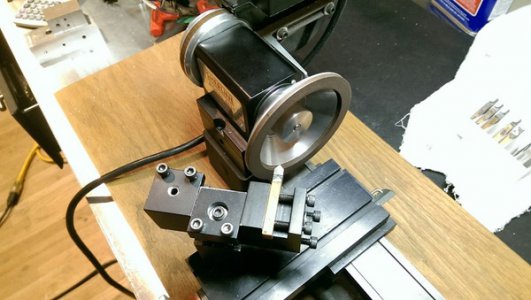- Joined
- Feb 5, 2015
- Messages
- 662
Brazed Carbide Lathe Cutting Tools
Although carbide cutters are useful for several performance advantages, brazed carbide lathe tools are often used by hobbyists because they are readily available and inexpensive. Some, new at this craft, might also choose them because they believe that the correct cutting geometry already exists “out of the box”.
The quality may not be optimum but you get what you pay for, right ? Some of them might actually have reasonable cutting geometry from the factory but most are sort of blunt instruments:
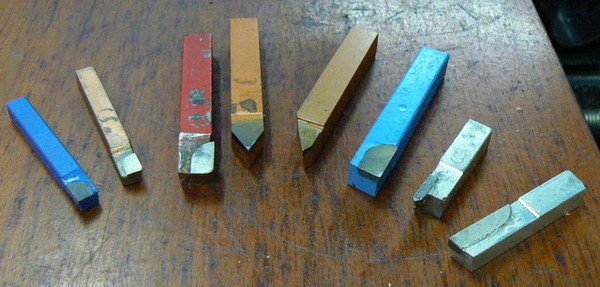
These tools universally have neutral rake and that’s OK for most purposes, although not optimal for small lathes. Often, there is little or no front or side clearance and the shank of the tool, to which the carbide cutter is brazed, also might need some relief.
Cutting Speed
Older machines have fairly low spindle speeds (as do larger lathes, even of recent manufacture). Carbide cutters perform best at high speeds, low RPM suggests that carbide tooling can’t be used to best efficiency.
I’m an advocate of HSS lathe cutters (and learning to grind them properly, of course). My small lathes are limited to spindle speeds of 1600 and 2100 RPM, correct for HSS tooling, but like most of us I find uses for carbide cutters.
HSM Uses For Carbide Cutters
The most obvious use is cutting hard materials that would quickly wear HSS. The photo shows a hardened tailstock center with a neck, turned with an AR brazed carbide tool.
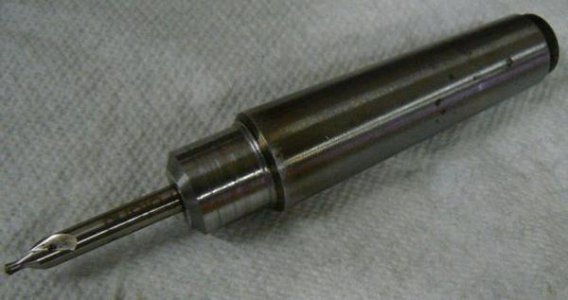
In this photo, the cutting surfaces of the broach at upper right was finish machined with a carbide end mill after hardening. There were no issues when cutting the hardened O-1 material.
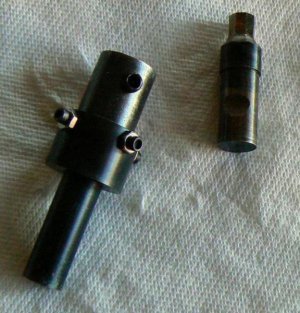
There are other applications and the need for carbide cutting tools will likely be obvious at the time. But the main utility of carbide tooling is that it can remove material quickly leaving a good finish. This of course assumes that the spindle speed of the lathe is high enough to be effective. Generally, for steel, this would be around 300 – 500 SFM and about twice that for most non-ferrous material.
A Typical Method Of Sharpening Carbide Cutters
One might get lucky and buy a brazed carbide tool that is sharp and has reasonable cutting geometry. But that’s not always the case and the tool must be ground to the correct geometry and sharpness. The geometry is not within the scope of this thread but you may find some ideas in the following:
http://www.hobby-machinist.com/threads/sharpening-cutting-tools.32987/
Normal procedure for grinding a brazed carbide tool is to first grind away a little of the steel shank underneath the front and under the cutting edge. The reason for this is to better expose the actual cutting edges of the brazed carbide for sharpening.
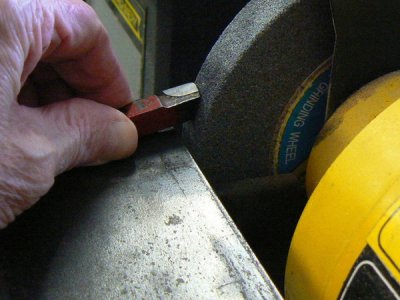
After grinding the shank as shown above, a “green wheel” is used to dress the carbide cutting tool, often followed by a few strokes from a diamond lap for finishing. The AL cutter in the second photo has been stroked with the diamond lap on the cutting edge.
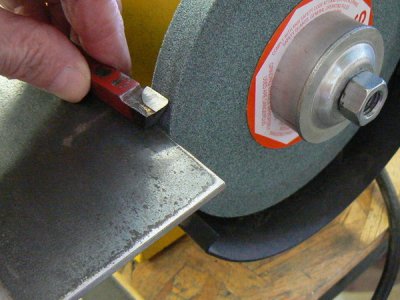
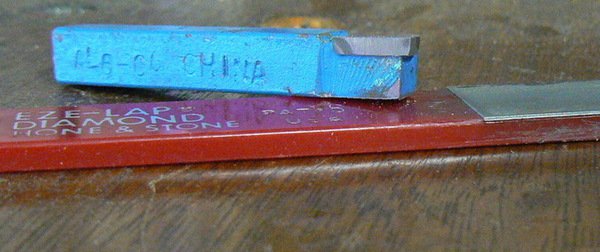
A fine-grit diamond grinding wheel is probably the best tool for dressing carbide cutters but that is a rare commodity among the HSM community. I actually have a diamond wheel and intend to mate it with a motor but the motivation to do so has been eluding me …
Some Considerations of Practicality And Cost
OK, let’s move on, two questions immediately come to mind:
Is it really necessary to sharpen these cheap brazed carbide cutters?
Is it really necessary to set up another grinder with a green wheel (not cheap) for carbide?
Diamond Cutting Wheels For Dremel Tool
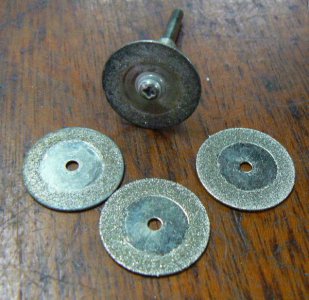
These things are approximately .75 inches in diameter and are available from HF for about $1 U.S. as I recall. I bought a few of them about ten years ago and the price may have risen in that time. The little wheels have diamond grit embedded on the rim and on the face and are especially handy for cutting.
It occurred to me that a little diamond wheel could also be useful for dressing a carbide cutting tool so I decided to give it a try. My first trial simply used the wheel as it was intended: in a Dremel tool. I clamped a carbide cutter in a vise and ground the cutting edge by hand with the face of the wheel.
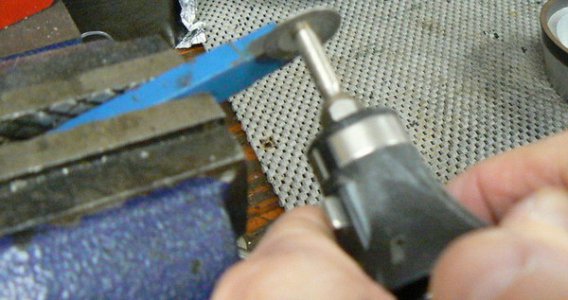
Hey, this worked pretty well, the diamond wheel cut the carbide readily. But thinking that a lot of folks may not have a Dremel tool, I hit on the idea of putting the wheel in a drill press.
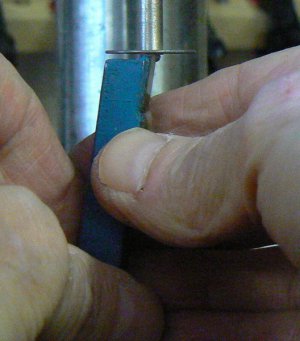
Again, it worked well despite the much lower speed compared to the Dremel. A little care must be exercised since the lower speed tends to make the wheel “grab” the tool.
And that got me thinking again. I put the tool in a small drill press vise at the correct angle, positioned it under the wheel and carefully fed the wheel into the cutter using the normal drill press handle. I think that it would work even better if the vise was secured to the drill press table.
I'm sorry about the poor quality of the photo - you have to look carefully to discern the little wheel and the end of the cutting tool.
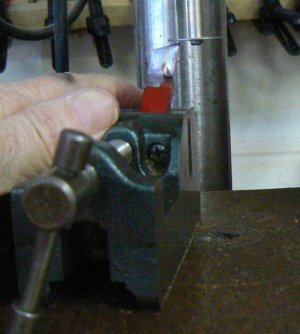
This worked best of the three trials and took only a few minutes to grind both cutting edges of the carbide tool. And if a compound angle is required, which would be common, taping a piece of scrap under one side of the vise to angle it would be practical.
In conclusion, I think that this is a perfectly viable way to sharpen carbide cutters with a minimal investment in tooling.
Although carbide cutters are useful for several performance advantages, brazed carbide lathe tools are often used by hobbyists because they are readily available and inexpensive. Some, new at this craft, might also choose them because they believe that the correct cutting geometry already exists “out of the box”.
The quality may not be optimum but you get what you pay for, right ? Some of them might actually have reasonable cutting geometry from the factory but most are sort of blunt instruments:

These tools universally have neutral rake and that’s OK for most purposes, although not optimal for small lathes. Often, there is little or no front or side clearance and the shank of the tool, to which the carbide cutter is brazed, also might need some relief.
Cutting Speed
Older machines have fairly low spindle speeds (as do larger lathes, even of recent manufacture). Carbide cutters perform best at high speeds, low RPM suggests that carbide tooling can’t be used to best efficiency.
I’m an advocate of HSS lathe cutters (and learning to grind them properly, of course). My small lathes are limited to spindle speeds of 1600 and 2100 RPM, correct for HSS tooling, but like most of us I find uses for carbide cutters.
HSM Uses For Carbide Cutters
The most obvious use is cutting hard materials that would quickly wear HSS. The photo shows a hardened tailstock center with a neck, turned with an AR brazed carbide tool.

In this photo, the cutting surfaces of the broach at upper right was finish machined with a carbide end mill after hardening. There were no issues when cutting the hardened O-1 material.

There are other applications and the need for carbide cutting tools will likely be obvious at the time. But the main utility of carbide tooling is that it can remove material quickly leaving a good finish. This of course assumes that the spindle speed of the lathe is high enough to be effective. Generally, for steel, this would be around 300 – 500 SFM and about twice that for most non-ferrous material.
A Typical Method Of Sharpening Carbide Cutters
One might get lucky and buy a brazed carbide tool that is sharp and has reasonable cutting geometry. But that’s not always the case and the tool must be ground to the correct geometry and sharpness. The geometry is not within the scope of this thread but you may find some ideas in the following:
http://www.hobby-machinist.com/threads/sharpening-cutting-tools.32987/
Normal procedure for grinding a brazed carbide tool is to first grind away a little of the steel shank underneath the front and under the cutting edge. The reason for this is to better expose the actual cutting edges of the brazed carbide for sharpening.

After grinding the shank as shown above, a “green wheel” is used to dress the carbide cutting tool, often followed by a few strokes from a diamond lap for finishing. The AL cutter in the second photo has been stroked with the diamond lap on the cutting edge.


A fine-grit diamond grinding wheel is probably the best tool for dressing carbide cutters but that is a rare commodity among the HSM community. I actually have a diamond wheel and intend to mate it with a motor but the motivation to do so has been eluding me …
Some Considerations of Practicality And Cost
OK, let’s move on, two questions immediately come to mind:
Is it really necessary to sharpen these cheap brazed carbide cutters?
Sharpening the cutting edge (the left side face of an AR tool for turning applications) certainly lessens the requirements of motor horsepower and machine rigidity (and may improve surface finish) but the cutting edge may become fragile and break down in an interrupted cut or when encountering a shoulder.
Is it really necessary to set up another grinder with a green wheel (not cheap) for carbide?
It depends. If one has the space, the means and the motivation then a separate grinder for carbide – green wheel and/or diamond wheel with vacuumed exhaust – is desirable. Space might be the limitation for many of us so now we come to the point and thank you for being patient.
Diamond Cutting Wheels For Dremel Tool

These things are approximately .75 inches in diameter and are available from HF for about $1 U.S. as I recall. I bought a few of them about ten years ago and the price may have risen in that time. The little wheels have diamond grit embedded on the rim and on the face and are especially handy for cutting.
It occurred to me that a little diamond wheel could also be useful for dressing a carbide cutting tool so I decided to give it a try. My first trial simply used the wheel as it was intended: in a Dremel tool. I clamped a carbide cutter in a vise and ground the cutting edge by hand with the face of the wheel.

Hey, this worked pretty well, the diamond wheel cut the carbide readily. But thinking that a lot of folks may not have a Dremel tool, I hit on the idea of putting the wheel in a drill press.

Again, it worked well despite the much lower speed compared to the Dremel. A little care must be exercised since the lower speed tends to make the wheel “grab” the tool.
And that got me thinking again. I put the tool in a small drill press vise at the correct angle, positioned it under the wheel and carefully fed the wheel into the cutter using the normal drill press handle. I think that it would work even better if the vise was secured to the drill press table.
I'm sorry about the poor quality of the photo - you have to look carefully to discern the little wheel and the end of the cutting tool.

This worked best of the three trials and took only a few minutes to grind both cutting edges of the carbide tool. And if a compound angle is required, which would be common, taping a piece of scrap under one side of the vise to angle it would be practical.
In conclusion, I think that this is a perfectly viable way to sharpen carbide cutters with a minimal investment in tooling.

